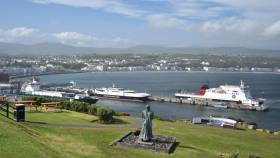Displaying items by tag: Tynwald Q's
Overall the total cost of the Isle of Man Steam Packet Company's new flagship ferry is expected to be £80m, confirmed the Manx Treasury Minister, reports BBC News.
According to the Minister, Dr. Alex Allinson, an additional £2m is on top of the planned £78m budget that had been spent on getting the built in Asia Manxman ready "into service".
The newbuild has a passengers and crew total of 1000 and as for vehicles, there is capacity for 237 private-motorists and 75 freight-trailers.
At the Manx Parliament, the Tynwald is where the Minister told members of the final adjustments made to the figure were "likely" as part of the IOM Steam Packet's year-end processes.
The 24,161 gross tonnes flagship, the biggest ever IOMSP ferry was constructed at the Hyundai Mipo Dockyard (HMD) in Ulsan, South Korea, which arrived in Manx waters in July. In the following month, the 133m flagship made its maiden voyage on the Douglas-Heysham route, the main and only year-round operated route of the Manx Government owned company's route network.
In the ferry firm's directors' report for 2022, it stated the project was forecast to be "complete within its estimated budget of £78m".
Dr. Allinson also confirmed the extra funds had been needed for trials at various ports, in addition for the evacuation system training, cutlery, crockery, bedding and other equipment needed for use of passengers.
The Minister was questioned by Juan Watterson, SHK on the costs involved as engineers from HMD, are currently working on board trying to address "vibration problems" experienced on the ferry, in which Dr Allinson believed the work would be covered by the agreed warranty.
More here on the rising cost of the new ferry.
Isle of Man Questions Stack-Up at Steam Packet
#FerryNews - It may be the summer recess at the Tynwald, the Isle of Man's parliament, but questions are still being asked about the Steam Packet.
As IOMToday reports there are 12 separate questions surrounding the ferry company (see acquired by Manx Government) out of the 57 questions for written answer from Tynwald members.
Members can ask written questions during the recess, with responses due yesterday, August 21.
Of the 12, 11 questions come from Liberal Vannin leader, Kate Beecroft (Douglas South) with the other from Rob Callister (Onchan), both asking questions relating to the proposed Princes Half-Tide Dock.
Mr Callister’s question, for the Minister for Infrastructure Ray Harmer, relates to whether the current contract between Peel Holdings and the Steam Packet relating to access to Pier Head can be extended beyond the end of 2019 and what facilities will be in place from January 1 2020.
For much more on the story, click here.






























































